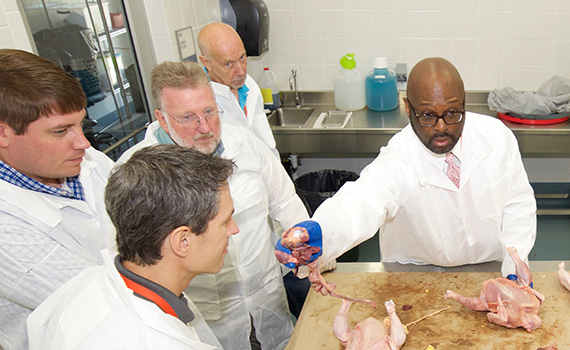Good communication key to protecting poultry parts during FSIS inspection
One key to food safety is designing and implementing poultry-inspection protocols that reflect consumer behavior. For example, federal inspectors are refocusing their strategy to address consumer demand for thighs, breasts and other parts instead of only whole birds.
“We have had standards for carcasses for years,” said Edward Hepburn, DVM, of the USDA Food and Safety Inspection Service (FSIS) in Athens, Georgia.
“However, we noticed that some poultry parts were missing intervention — and people were getting sick on chicken parts. That’s why they came up with parts standards. As you see in your processing plants now, you probably are getting more requests for parts sampling.”
Hepburn discussed the practical implications of increased parts inspection at the “Young Chicken Gross Pathology Workshop” held at the Georgia Poultry Laboratory in Gainesville. Zoetis sponsored the 2016 meeting.
High-tech approach
Regulations often take a one-size-fits-all approach that may not be relevant to each individual plant. The Public Health Information System (PHIS), however, now enables inspectors to tailor programs that are both practical and more effective. Hepburn cited several questions that inspectors ask when setting up a profile for parts inspection:
- How many pounds of wings do you produce in a month?
- How many pounds of legs do you produce?
- Is it going directly to consumers?
- Is it going ready to eat?
“All of this information is compiled into PHIS, and it comes up with a program for your particular establishment,” he said.
Following directives
Of course, any government-administered program comes with ample documentation. It may be tempting to set it aside for a rainy day, but Hepburn encouraged processors to make an effort to read and understand FSIS directives.
“I always recommend that plants use and read the directives that come to us,” he said. “Directives are nothing but instructions from our headquarters, from our agency to the inspection staff. It’s important for you to understand why we do certain things and what we are doing. In this particular case, they tell us how to take samples.”
What specifically does sampling entail? Hepburn covered several points.
- Only finished products are sampled. “This is where you are wrapping and packaging, and it’s going either to consumers or ready-to eat plants.”
- All categories are included. “They include intact, non-intact, skinless and boneless — all chicken-part categories. People tell me all the time, ‘Doc, we marinate this product. You know, we have this great pepper sauce.’ It goes to the consumer, correct? So they’re going to test that product.”
- Immediate results are available. “I hope all of you who produce poultry are part of the Laboratory Information Management System. This allows you to get the results of the test directly to you. We get them at the same time that you do. And it’s important for your process to know what your result is.”
- No single result is actionable. “We’re looking at the entire system, so if you come up positive for Salmonella or Campylobacter on one result, it’s not really a big deal. But it’s something that alerts you, saying, ‘maybe our sanitary dressing is not correct.’”
- Food safety requires a team effort. “We want to reduce pathogens in poultry products by 30%. It’s going to take all of us to do it.”
Not the final word
Despite technical advances, human judgment will always be central to the inspection process. This is why FSIS not only allows but also encourages processors to appeal decisions with which they disagree.
“This is absolutely your right,” Hepburn said. “By regulation, you should do it within 48 hours. You want your appeal to be right. However, filing your appeal or notifying the inspection staff that you want to appeal — which can be written or verbal — as early as possible into that process is best for all of us.”
He shared a few practical tips for filing an appeal. “We encourage you to appeal first to the author of the report,” he said. “I like it in writing, because in a poultry plant, communication sometimes falls through the cracks. It can be as easy as an email: ‘Hey, Doc, we’re going to appeal NR 5842.’”
Perhaps the most important reminder for processors and inspectors alike is to communicate clearly and frequently.
“Use your forum to voice things that are going on in the plant,” Hepburn said. “I hate to see weekly meeting notes with only my people saying something, because I know you guys have a lot to say. But I don’t see any of that on my weekly meetings. I want that to change.”
Emerging technology
Finally, Hepburn encouraged processors to get behind the New Poultry Inspection System (NPIS).
“They want to modernize poultry inspection,” he said. “This is one of the biggest moves and biggest changes in inspection in over 100 years. The plant disposes, and we condemn. Your requirement is to meet the regulatory requirement. Our job is to verify.”
What will the future look like when NPIS is fully implemented?
“The standard is long and drawn-out,” Hepburn said. “But what it basically is saying is that at the end of your process, I can pull one carcass off the line and I should be able to put salt and pepper on it, marinate it and cook it without further trimming or anything else.”
Hepburn acknowledged that this isn’t easy to do. “But this is the standard that the agency put down — ready-to-cook,” he added. “Your process has to show that you’re ready to cook your NPIS bird.”
See related articles:
Exploring the cause of condemnations can reduce losses
Observe, judge, act — Veterinarian offers practical tips for reducing carcass condemnations
Condemnations, mortality shift focus to E. coli vaccination in some broiler flocks
E. coli in broilers: Its costly impact on condemnations and mortality
Salmonella prevention requires teamwork between production and processing
Posted on February 10, 2017

















